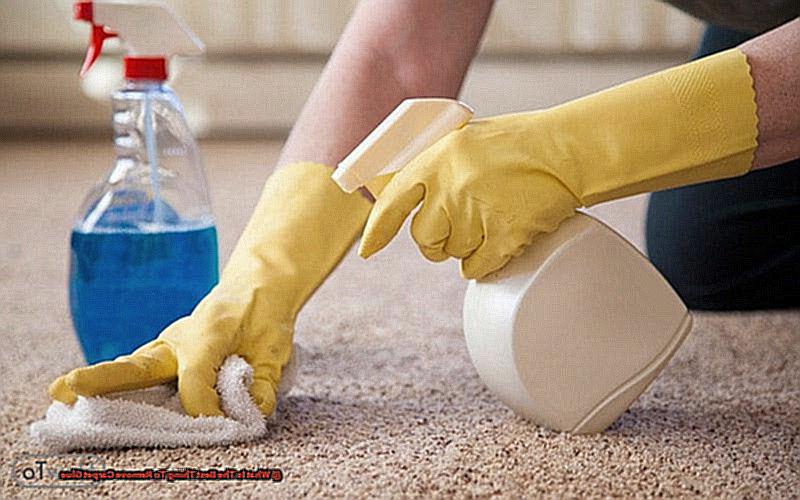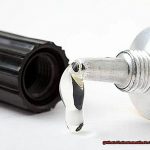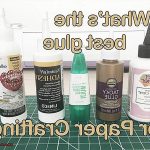Picture this: a space adorned with beautiful carpeting, providing comfort and warmth with every step. But when it’s time for a flooring upgrade, the stubborn residue left behind by carpet glue can be quite the headache. Don’t fret. In this blog post, we’ll dive into the world of removing carpet glue and arm you with the knowledge needed to restore your floors to their former glory.
Removing carpet glue may seem like a meticulous task, but fear not. With the right techniques and products at your disposal, you can make this process much more manageable. Our goal is to guide you through each step of this journey, ensuring impeccable results while preserving the integrity of your floors.
Throughout this comprehensive guide, we’ll explore the most effective methods for eradicating carpet glue from various surfaces like concrete, hardwood, and tile. Whether you’re dealing with dried-up patches or residual adhesive, we’ve got you covered.
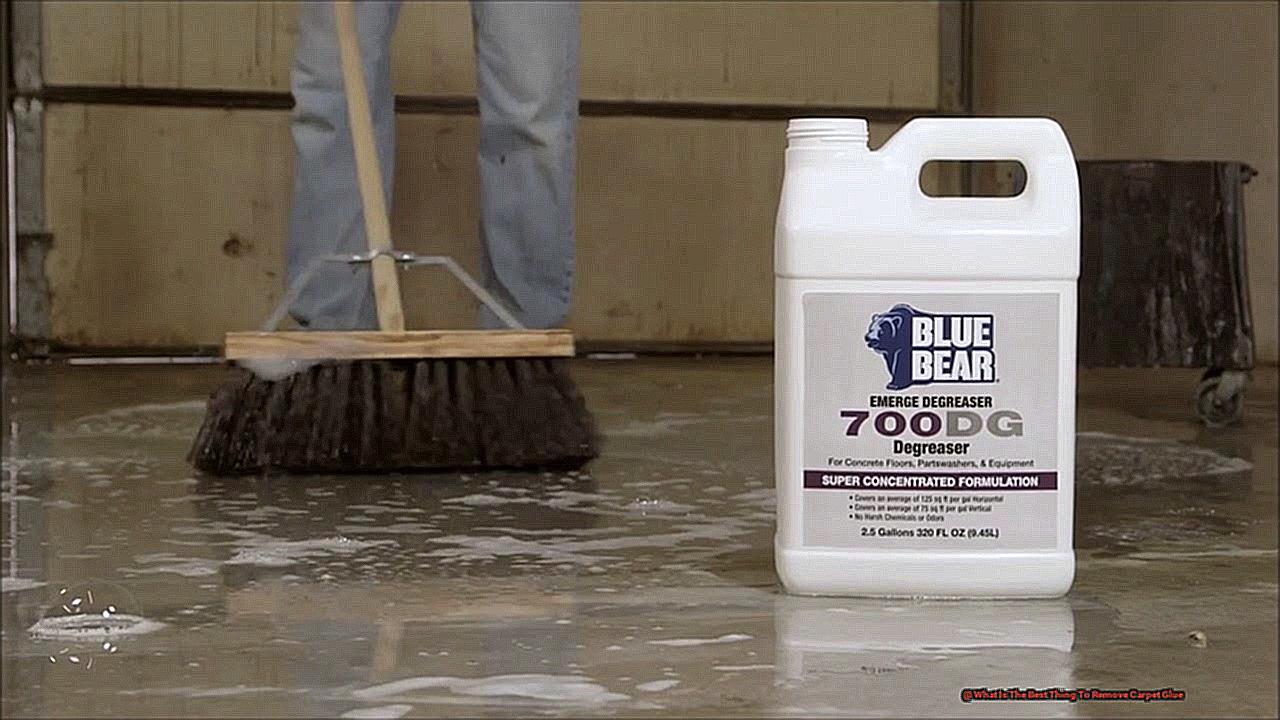
So roll up those sleeves and prepare to bid farewell to carpet glue once and for all. Get ready as we unlock the secrets to revealing pristine floors that truly shine. Let’s dive into effective removal methods together.
What is Carpet Glue?
Contents
- 1 What is Carpet Glue?
- 2 Heat Method for Removing Carpet Glue
- 3 Solvent Method of Removing Carpet Glue
- 4 Mechanical Methods of Removing Carpet Glue
- 5 Choosing the Best Method for Your Situation
- 6 Safety Precautions When Removing Carpet Glue
- 7 Testing a Solvent on an Inconspicuous Area Before Use
- 8 Pros and Cons of Different Methods for Removing Carpet Glue
- 9 Conclusion
Carpet glue is a vital component in ensuring that your carpets stay firmly in place, enduring heavy foot traffic and adding a touch of warmth and comfort to any space. In this comprehensive guide, we will explore the different types of carpet glue available on the market and provide insights into effective techniques for removing and replacing carpets.
Types of Carpet Glue:
- Latex-based carpet glue: Ideal for residential applications, this adhesive offers easy application and water resistance. Its versatility allows for indoor and outdoor use, making it suitable for various flooring projects.
- Acrylic-based carpet glue: Commonly used in commercial settings, acrylic-based adhesive boasts exceptional durability and resistance to heavy foot traffic. Its moisture resistance makes it perfect for areas prone to spills or high humidity levels.
- Solvent-based carpet glue: Found in industrial applications, this quick-drying glue provides a high bond strength. However, caution must be exercised as it emits strong fumes during application and requires well-ventilated areas.
Carpet Glue Removal Techniques:
- Heat method: Soften the glue by applying gentle heat using a heat gun or an iron set to low heat. Once softened, carefully scrape off the glue with a scraper or putty knife, avoiding overheating or damaging the carpet fibers.
- Solvents or adhesive removers: Apply a suitable solvent or adhesive remover to break down the adhesive properties of the glue. Test the solvent on a small inconspicuous area first to ensure it does not damage the floor. Wipe away the softened glue using a cloth or sponge.
- Mechanical methods: For stubborn carpet glue residue, mechanical methods such as scraping or sanding may be necessary. Use a scraper or sandpaper to physically remove the glue, taking care not to damage the underlying flooring material.
Heat Method for Removing Carpet Glue
Removing carpet glue can be a daunting task, but fear not. With the heat method, you can say goodbye to that stubborn adhesive. In this guide, we will explore the ins and outs of using heat to soften carpet glue, equipping you with the knowledge needed to tackle this project like a pro.
Safety Precautions:
Before diving into the heat method, let’s prioritize safety. Here are some precautions to keep in mind:
- Protect yourself: Don protective gloves and goggles to shield your skin and eyes from any potential harm caused by heat or chemical adhesive removers.
- Ventilation is key: Ensure proper air circulation during the glue removal process by opening windows or using fans. This minimizes exposure to potentially harmful fumes released by certain adhesives.
The Heat Method:
Now let’s delve into the heat method itself. Follow these steps for effective carpet glue removal:
- Test a small area: Begin by testing the heat method on a small, inconspicuous area of your carpet. Assess the effects of the heat on both the glue and carpet fibers to prevent any damage before proceeding further.
- Apply heat directly: Use a heat gun or hairdryer on its highest setting to apply concentrated heat directly onto the glue. The heat will soften the adhesive, making it easier to remove. Keep the heat source moving constantly and avoid holding it in one spot for too long to prevent damage or fire hazards.
- Scrape away softened glue: After applying heat, gently scrape away the softened glue using a scraper or putty knife. Apply some pressure if necessary, but be cautious not to damage the carpet fibers.
- Treat persistent remnants: If any remnants of glue remain after scraping, treat them with adhesive removers specifically designed for removing carpet glue. Follow the manufacturer’s instructions and use these removers sparingly.
- Thoroughly clean and rinse: Once all the glue has been removed, thoroughly clean and rinse the area to eliminate any remaining residue or cleaning products. Warm water with a mild detergent or a carpet cleaning machine can be used for this purpose.
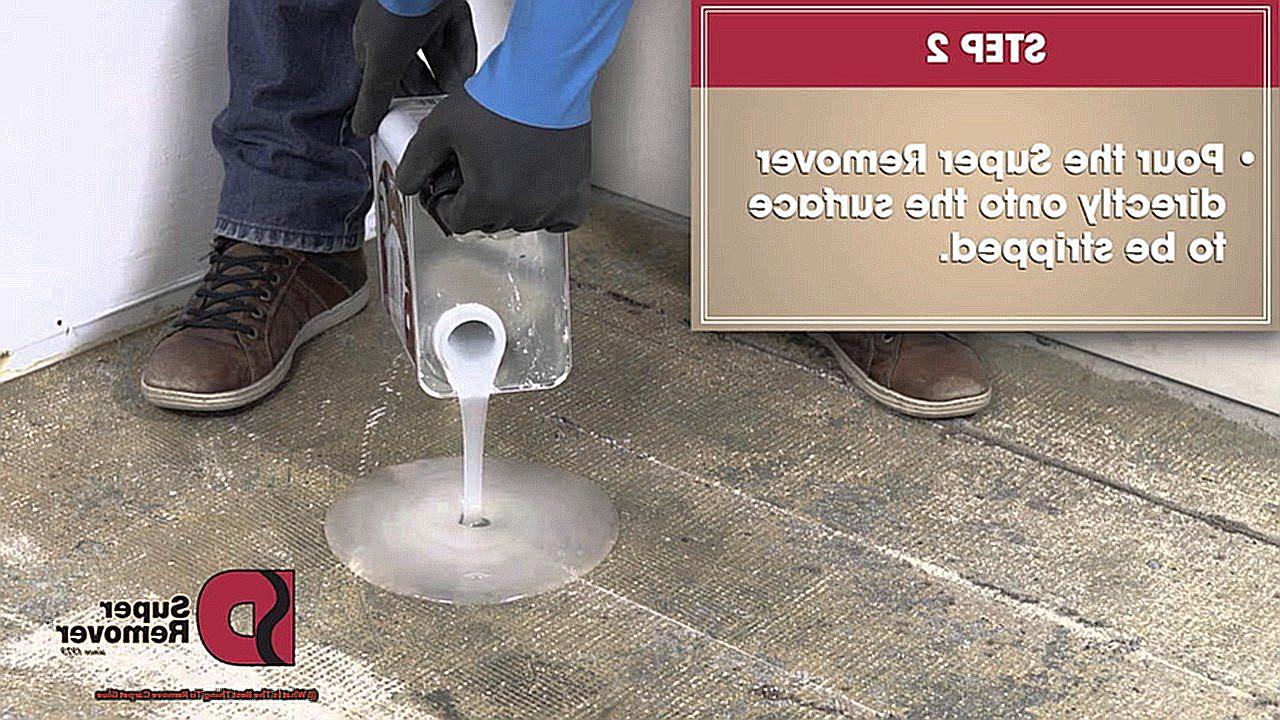
Variations in Effectiveness:
It’s important to note that the effectiveness of the heat method may vary depending on factors such as the type and age of the glue, as well as the type of carpet. For optimal results, consult a professional or conduct thorough research before attempting any DIY carpet glue removal methods.
Solvent Method of Removing Carpet Glue
The solvent method is here to save the day. This tried and true technique is not only effective, but it’s also one of the most commonly used methods for removing carpet glue.
So what exactly is a solvent? It’s a powerful chemical substance that has the incredible ability to dissolve or liquefy glue, making it a breeze to remove from any surface. There are several types of solvents that can be used for this purpose, including acetone, mineral spirits, and adhesive removers.
Acetone, often found in nail polish removers, is a potent solvent that can break down and remove carpet glue. However, it’s important to exercise caution when using acetone, as it is highly flammable and can damage certain surfaces.
If you’re looking for a safer option without compromising effectiveness, mineral spirits, also known as white spirits, are an excellent choice. They are less harsh than acetone and can be used on a wider range of surfaces without causing damage.
Another option to consider is adhesive removers. These specialized products are designed specifically to remove adhesives like carpet glue. They come in both liquid and gel forms and can be easily applied to the glue for effective removal.
Now that you know your options, let’s discuss the steps involved in using solvents to remove carpet glue. First and foremost, it’s crucial to read and follow the instructions provided by the manufacturer of the solvent you choose. Safety should always come first, so make sure to wear gloves and work in a well-ventilated area.
Once you have taken the necessary safety precautions, apply the solvent directly to the carpet glue and let it sit for a few minutes. This allows the solvent ample time to penetrate and break down the adhesive. After the glue has softened, use a scraper or putty knife to gently scrape it away.
It’s important to note that you may need to repeat the application of the solvent and scraping process multiple times to completely remove the carpet glue, especially if it’s stubborn or old. Be patient and persistent, and you’ll eventually bid farewell to that pesky glue for good.
After removing the carpet glue, don’t forget to clean the surface thoroughly with warm soapy water to remove any residue left behind by the solvent.
Lastly, it’s crucial to remember that not all solvents are suitable for all types of carpets or surfaces. To avoid any damage or discoloration, be sure to test the solvent on a small, inconspicuous area before using it on the entire surface.
Mechanical Methods of Removing Carpet Glue
There are several mechanical methods that can help you remove that pesky adhesive and restore your floors to their former glory. In this article, we’ll explore these methods and provide some safety precautions to keep in mind while using them.
Firstly, one common method involves using a floor scraper or putty knife. With patience and persistence, you can manually scrape away the glue using a sharp and sturdy scraper. Remember to work slowly and apply consistent pressure. To protect yourself from flying debris, wearing gloves and eye protection is essential.
For larger areas or heavily glued surfaces, a floor buffer or sander with a coarse grit sandpaper attachment can be utilized. This more aggressive method effectively grinds away the glue. However, it’s important to test this method on a small area first to avoid any damage that might occur as it may remove a thin layer of the flooring material.
If you’re dealing with smaller and hard-to-reach areas such as corners or edges, a handheld rotary tool with a wire brush attachment is ideal. This method allows you to scrub off the glue by loosening it with the wire brush. Take caution and precision to prevent any scratching or damaging of surrounding materials.
Another mechanical option involves using heat to soften the adhesive. A heat gun or hairdryer can be used to heat the glue, making it easier to scrape off with a scraper or putty knife. However, be cautious as excessive heat can damage the flooring or create harmful fumes.
Remember, mechanical methods require physical effort and may take some time, but they can be highly effective in removing stubborn adhesive residues. Choose the appropriate method based on the size of the area, type of flooring material, and condition of the glue.
Always follow safety precautions and test the method on a small area first to avoid unintended damage.
Choosing the Best Method for Your Situation
Before charging into battle armed with a scraper and determination, take a moment to consider the best method for your situation. Choosing the right technique will ensure efficient and effective removal of the glue without causing any damage.
So gear up and let’s dive into the battlefield of carpet glue removal, equipping you with the knowledge you need to emerge victorious.
Factor 1: Type of Glue:
Not all glues are created equal, and neither are the methods used to remove them. Some glues are water-based, while others are solvent-based. Before selecting a removal method, identify the type of glue used. This crucial step will help you choose the right approach, ensuring maximum effectiveness.
Factor 2: Surface Type:
Carpet glue can cling to various surfaces like concrete, wood, or tile. Each surface requires different removal techniques to prevent damage. Consider the material you’re dealing with and choose a method suitable for that surface.
Factor 3: Size of the Area:
Is it just a small spot of glue or an entire room covered in adhesive nightmare? The size of the area determines which method is most appropriate. Opt for quick and easy techniques for smaller areas, while larger spaces may require more time-consuming but thorough methods.
Factor 4: Environmental and Health Concerns:
Safety first. Some removal methods involve harsh chemicals or produce fumes that can be harmful if not used properly. Consider any environmental or health concerns and prioritize your well-being by choosing a safe method that aligns with your preferences and needs.
Factor 5: Experience and Comfort Level:
Are you a seasoned DIY warrior or a novice on the battlefield? Different methods require varying levels of experience and may involve specialized tools or equipment. Choose a method that matches your skill level, ensuring a successful carpet glue removal mission.
Safety Precautions When Removing Carpet Glue
Removing carpet glue can be a challenging and potentially hazardous task. Whether you are a professional or a DIY enthusiast, it is crucial to prioritize safety throughout the process. Here are some essential safety precautions to consider when removing carpet glue:
- Ventilation is key: Before you embark on the glue-removal journey, ensure that the work area is well-ventilated. Open windows and doors to promote fresh air circulation, allowing any fumes or odors to dissipate quickly.
- Armor up: Protect yourself by wearing appropriate safety gear. This includes sturdy gloves to shield your hands from potential contact with the glue or chemicals used, as well as safety goggles to protect your eyes. Additionally, consider wearing a mask to safeguard against inhaling fumes and dust particles.
- Read and follow instructions: Different adhesive removers have varying application methods and safety precautions. Take the time to carefully read and follow the manufacturer’s instructions provided with the product. This will ensure safe and effective usage.
- Shed light on the situation: Working in a well-lit area is vital for good visibility and reducing the risk of accidents or injuries during the carpet glue removal process.
- Skin protection matters: When using chemical solvents, avoid direct contact with your skin. In case of spills or splashes, promptly wash the affected area with soap and water to minimize any potential harm.
- Beware of respiratory irritants: Some adhesive removers may emit fumes that can irritate your respiratory system. If you experience any discomfort or breathing difficulties, immediately move to a well-ventilated area.
- Seek urgent medical attention: Accidental ingestion or inhalation of any chemicals should not be taken lightly. If such an incident occurs, seek immediate medical attention and provide detailed information about the specific product used.
- No smoking or open flames: For safety reasons, refrain from smoking or using open flames in the vicinity of the glue removal process. Some solvents may be flammable, posing a significant risk of fire or explosion.
- Keep children and pets at bay: To ensure their safety and prevent accidental exposure to chemicals or potentially dangerous tools, keep children and pets away from the work area.
- Dispose of waste responsibly: Properly dispose of any waste materials associated with the glue removal process. This includes used adhesive remover containers and rags soaked in solvent. Adhere to local regulations for safe disposal methods to protect the environment and prevent any potential harm.
Testing a Solvent on an Inconspicuous Area Before Use
If you’re on a mission to remove carpet glue, then testing a solvent on an inconspicuous area is a crucial step. This little precautionary measure can save you from a world of trouble and ensure the safety of your precious carpet fibers.
So, why bother testing a solvent on a hidden corner of your carpet? It’s all about playing it safe, my friend. By doing a quick test, you can assess the effectiveness of the solvent and prevent any potential disasters like discolored or damaged carpet.
Let’s talk about the benefits of testing a solvent in an inconspicuous area. First off, it allows you to observe any changes in color, texture, or damage. Imagine applying a solvent directly onto your beautiful carpet only to find out later that it turned into a patchy mess. Yikes. By testing first, you can avoid such nightmares and make an informed decision.
Now, which solvents should you test? It depends on the type of glue you’re dealing with. Acetone, isopropyl alcohol, and citrus-based cleaners are commonly used for removing adhesive residues. However, each type of glue may react differently to solvents and carpets. That’s where the inconspicuous area comes into play – it’s like your secret test lab.
But wait, there’s one more thing to consider. Some solvents can pack a punch with their strong odors or fumes. You don’t want to be caught off guard by those toxic vapors. So make sure you perform the test in a well-ventilated area or gear up with gloves and masks for extra protection.
Pros and Cons of Different Methods for Removing Carpet Glue
When it comes to removing carpet glue, there are various methods at your disposal. Each method has its own set of pros and cons, so it’s crucial to weigh your options before deciding which approach to take. Here’s a breakdown of the most common methods for removing carpet glue and their respective advantages and disadvantages.
Heat Gun Method:
- Pros: Using a heat gun is a quick solution, as the heat softens the glue, making it easier to scrape off. It’s less messy compared to other methods since it doesn’t involve chemicals.
- Cons: A heat gun can be dangerous if not used properly, as high temperatures can cause burns or damage to surrounding materials. It may not be as effective for deep-seated or stubborn adhesive.
Chemical Solvents:
- Pros: Chemical solvents break down the adhesive properties of the glue, making it easy to wipe away or scrape off. They are generally effective for all types of carpet glue.
- Cons: Many solvents contain strong chemicals that can be harmful if inhaled or come into contact with skin. Protective gear such as gloves and a mask are necessary. Some solvents may leave behind a strong odor or residue that requires thorough cleaning.
Mechanical Methods:
- Pros: Scraping or sanding off the glue using tools like scrapers, sandpaper, or a floor buffer with abrasive pads is effective for even the toughest adhesive. No chemicals are involved, making it safer.
- Cons: Mechanical methods can be time-consuming and labor-intensive, especially for larger areas. There is a risk of damaging the underlying surface if excessive force is applied or if the wrong tools are used.
Natural Remedies:
- Pros: Natural remedies like vinegar, baking soda, or citrus-based solvents are safe to use and environmentally friendly.
- Cons: They may not be as effective as other methods, especially for stubborn or aged glue. Multiple applications or extra scrubbing might be required. Some natural remedies may have a strong odor.
- Also Read: How To Remove Glue On Carpet?
Conclusion
When it comes to removing carpet glue, finding the best solution can be a sticky situation.
But fear not, for there are several powerful options that can help you bid farewell to that stubborn adhesive. One of the top contenders in this battle is acetone, a potent solvent known for its ability to dissolve glue with ease.
Another formidable opponent is citrus-based adhesive removers, which harness the power of natural oils to break down and remove the glue. For those seeking a more eco-friendly approach, soy-based solvents offer a greener alternative that is both effective and safe.
Remember, though, safety should always be your number one priority when using these methods – make sure to wear protective gear such as gloves and goggles.

